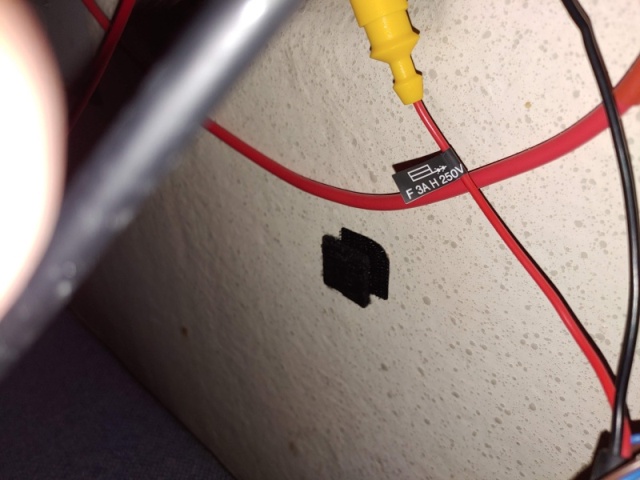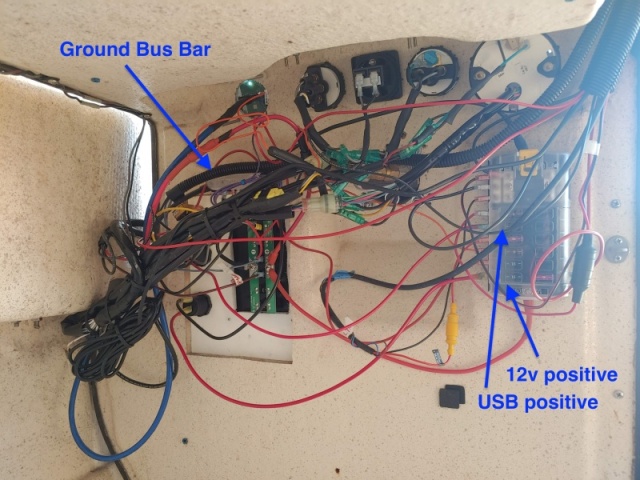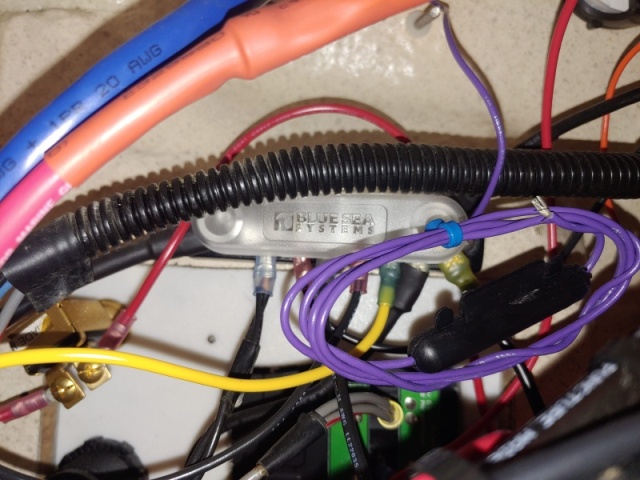| View previous topic :: View next topic |
| Author |
Message |
thataway
Joined: 02 Nov 2003
Posts: 20802
City/Region: Pensacola
State or Province: FL
C-Dory Year: 2007
C-Dory Model: 25 Cruiser
Vessel Name: thataway
Photos: Thataway
|
 Posted: Tue Oct 08, 2019 1:55 pm Post subject: Posted: Tue Oct 08, 2019 1:55 pm Post subject: |
 |
|
| BrentB wrote: | Bob and I have been emailing about the location Bob and Marie see nothing wrong and they have a lot of experience. Use it!
The pic with the yellow fuse holder could be removed. |
I should have clarified--any wires which go near the wheel or would be in the way when you operate the boat, can be held out of the way with velcro. For instant in the RV, I have 5 USB and Power cables going to instruments which are just below the driver's line of vision. All of these are secured with small velcro ties to keep them in place, and not interfere.
We have always added a number of extra 12 volt cigarette lighter type of receptacles . There are some which are not quite standard, and the plug will
either bind (in some cases not go in at all) and others where the fit is too loose, and the plug will not stay in.
For the ARB freezer in the cockpit, it comes with a cig. lighter plug, but you can screw off the outer part of the plug, and then put in a two wire plug into a two wire recptical, and the whole thing locks together with a wheel and cam, so the freezer will not come unplugged. If we have higher draw connections, we use "Anderson Power Pole Connectors" which give a positive "latch" and come in 15, 30 and 45 amps. The 30 and 45 will have at least #10, and #6 wire respectively.
_________________
Bob Austin
Thataway
Thataway (Ex Seaweed) 2007 25 C Dory May 2018 to Oct. 2021
Thisaway 2006 22' CDory November 2011 to May 2018
Caracal 18 140 Suzuki 2007 to present
Thataway TomCat 255 150 Suzukis June 2006 thru August 2011
C Pelican; 1992, 22 Cruiser, 2002 thru 2006
Frequent Sea; 2003 C D 25, 2007 thru 2009
KA6PKB
Home port: Pensacola FL |
|
| Back to top |
|
 |
bmcminn
Joined: 20 Jul 2019
Posts: 65
City/Region: Bellingham
State or Province: WA
C-Dory Year: 1992
C-Dory Model: 19 Angler
Vessel Name: Polū
Photos: bmcminn
|
 Posted: Sun Oct 13, 2019 2:58 am Post subject: Posted: Sun Oct 13, 2019 2:58 am Post subject: |
 |
|
I really appreciate everyones help on this one, thanks. An eventual project will be to build a little access panel to tuck everything away behind.
Micah, the yellow glass fuse is 3 amps and is inline to the Garmin GPS and connects to a 3A blade fuse on the fuse block. Any idea why?

Also, do you know why I have a ground bus bar in addition to the ground portion of the fuse block? I ran the positive from the 12V and USB to the fuse block and used 15A and 5A fuses and ran the negative to the ground bus bar. Should I have grounded them on the fuse block? It all works...


One last question, kinda two really, why didn't the person who wired it heat shrink the connectors? And should I (someday) pull them and heat shrink them and also use dielectric on all that exposed stuff?
Thanks. It all worked on my trip and made it much more comfortable. |
|
| Back to top |
|
 |
ssobol
Joined: 27 Oct 2012
Posts: 3370
City/Region: SW Michigan
State or Province: MI
C-Dory Year: 2008
C-Dory Model: 22 Cruiser
Vessel Name: SoBELLE
Photos: SoBelle
|
 Posted: Sun Oct 13, 2019 3:58 am Post subject: Posted: Sun Oct 13, 2019 3:58 am Post subject: |
 |
|
| bmcminn wrote: | ....
One last question, kinda two really, why didn't the person who wired it heat shrink the connectors? And should I (someday) pull them and heat shrink them and also use dielectric on all that exposed stuff?... |
I would say that if you have exposed screw terminals in an area that does not have much risk of water contact heat shrink joints and connections aren't going to mean a whole lot. The original wiring of the boat did not use heat shrink lugs and splices anywhere I can tell.
On my boat stuff I add in or directly adjacent to the cockpit gets heat shrink. Newer stuff under the sink usually gets it too (lately because I bought bags of heat shrink splices). Stuff elsewhere doesn't. I'm not about to redo everything just to put heat shrink lugs on stuff.
If it ain't broke don't fix it. |
|
| Back to top |
|
 |
Micahbigsur@msn.com
Joined: 27 May 2019
Posts: 484
City/Region: Big Sur
State or Province: CA
C-Dory Year: 2003
C-Dory Model: 25 Cruiser
Vessel Name: Sierra
Photos: Sierra
|
 Posted: Sun Oct 13, 2019 10:30 am Post subject: Posted: Sun Oct 13, 2019 10:30 am Post subject: |
 |
|
Yes unless in a damp or salt spray area no need to use heat shrink, though anything you add you can use crimp terminals that have the built in heat shrink.
Many things get added at different times in boats, if someone wanted an added ground they add a buss bar, that is fine, that one is a good one of a newer Blue-Seas style. It is neater if both the +&- are tied in close together. Make sure that both negative bars are tied together directly and not all the way back through the batteries, then they are essentially one.
The yellow glass fuse came with the unit so it could be tied directly into the positive 12v, in your system it is extraneous, adds another problem point just directly from the blade fuse is better...but make sure in your manual that it is a normal glass fuse not a "fast blow" or other weird fuse which is unlikely. If the fuse in it just says 3 amp it is the same as the blade fuse.
Try to bundle parallel wires with zip ties for neatness to avoid the rats nest look but I would not rewire what is working, adding new wires, run them alongside others and tie them together also neater, every time you undo a screw or add something use dielectric.
Good luck!
_________________
Micah Curtis and Dana, RN
2003 C-dory 25 Sierra, 200, 9.9 and 2.5 Suzukis
2012 R25 SC Sequoia (2015-2018)
1978 Folkes 38 SV Audacious (2006-2015)
Micah, KJ6GUF, Dana, KJ6GXG |
|
| Back to top |
|
 |
thataway
Joined: 02 Nov 2003
Posts: 20802
City/Region: Pensacola
State or Province: FL
C-Dory Year: 2007
C-Dory Model: 25 Cruiser
Vessel Name: thataway
Photos: Thataway
|
 Posted: Sun Oct 13, 2019 12:34 pm Post subject: Posted: Sun Oct 13, 2019 12:34 pm Post subject: |
 |
|
I agree with the above, except for one factor. That is I do use heat shrink where ever possible, especially if the boat is used in salt water. Just the salt air has enough salt to make corrosion more likely in the wires.
I have rewired 20 year old boats, which were kept in salt water, and even the Ancor tinned wiring which was in the interior had some corrosion. Any non tinned wire had extensive corrosion. The heat shrink terminals (there are some decent ones from China which are cheaper than Ancor in bulk), work very well, and you don't have to add adhesive heat shrink tubing, unless you damaged the outside of the insulation with the crimper.
As Ssobol, I have boxes of all size of adhesive heat shrink--cheaper if you buy in bulk..
I would not undo, unless you want to for neatness at this point. I would use the dielectric grease with all screw contacts.
As for the negative bus bar: it was probably put in for those items on the outboard size of the console. When you go along, you may want to shorten the coiled wire (except the outboard harness) |
|
| Back to top |
|
 |
BrentB
Joined: 15 Jul 2006
Posts: 4419
City/Region: Greenwood
State or Province: IN
Photos: BrentB
|
 Posted: Sun Oct 27, 2019 1:05 pm Post subject: Posted: Sun Oct 27, 2019 1:05 pm Post subject: |
 |
|
Are all connected devices working?
I would take the time the trace each connection and label them and draw a diagram.
At some time, start cleaning up the wiring will better crimp, shortening wires and securing them
_________________
Brent Barrett |
|
| Back to top |
|
 |
Chester
Joined: 04 Sep 2006
Posts: 1176
City/Region: home
State or Province: WA
C-Dory Year: 2005
C-Dory Model: 22 Cruiser
Vessel Name: Sold to lovely couple
Photos: Chester
|
 Posted: Sun Oct 27, 2019 11:42 pm Post subject: Posted: Sun Oct 27, 2019 11:42 pm Post subject: |
 |
|
Rather than di-electric grease I have started using NO-OX-ID which is supposed to improve conductivity and resist corrosion.
Is it that much better? I don't know yet but it gives me a warm fuzzy feeling.
https://www.sanchem.com/electrical-contact-lubricant.html |
|
| Back to top |
|
 |
Micahbigsur@msn.com
Joined: 27 May 2019
Posts: 484
City/Region: Big Sur
State or Province: CA
C-Dory Year: 2003
C-Dory Model: 25 Cruiser
Vessel Name: Sierra
Photos: Sierra
|
 Posted: Mon Oct 28, 2019 1:27 am Post subject: Posted: Mon Oct 28, 2019 1:27 am Post subject: |
 |
|
| Check the Practical Sailor testing of several anti corrosion products I seem to remember that NO-OX-ID was made with grey aluminum powder for home wiring an did not do well when mixed with copper and salt air. I used it until reading the review and have gone over to the insulating non metallic, more water resistant qualities of silicone diaelctric grease |
|
| Back to top |
|
 |
Chester
Joined: 04 Sep 2006
Posts: 1176
City/Region: home
State or Province: WA
C-Dory Year: 2005
C-Dory Model: 22 Cruiser
Vessel Name: Sold to lovely couple
Photos: Chester
|
|
| Back to top |
|
 |
BrentB
Joined: 15 Jul 2006
Posts: 4419
City/Region: Greenwood
State or Province: IN
Photos: BrentB
|
 Posted: Mon Oct 28, 2019 10:57 pm Post subject: Posted: Mon Oct 28, 2019 10:57 pm Post subject: |
 |
|
| good article! Thanks |
|
| Back to top |
|
 |
Micahbigsur@msn.com
Joined: 27 May 2019
Posts: 484
City/Region: Big Sur
State or Province: CA
C-Dory Year: 2003
C-Dory Model: 25 Cruiser
Vessel Name: Sierra
Photos: Sierra
|
 Posted: Tue Oct 29, 2019 1:40 am Post subject: Posted: Tue Oct 29, 2019 1:40 am Post subject: |
 |
|
Chester, it was good of you to find that article I was too lazy to drag out all my old issues to find it and using my phone gets tedious.
I see that I was using Noalox it's been a while and I had always used it wiring houses where it is very common.
Practical Sailor seems to like Green Grease which I wouldn't expect, I've used the lanolin based water resistant Lanocoat but I always thought that it was too messy for wiring. I wish they would test my favorite silicone diaelctric grease that I buy in large tubes at an electronics supply. I have done extensive wiring with it on 3 salt water boats over the last 15 years and on the Ranger Tug with a crazy amount of wiring and electronics under the leaky cockpit hatches it really saved me. I also find it works great on water filter o rings, hatch gaskets, stainless threds and sticky window slides, being muti-use it makes the cut for our limited storage space.
Thanks again!
Last edited by Micahbigsur@msn.com on Tue Oct 29, 2019 1:58 am; edited 2 times in total |
|
| Back to top |
|
 |
Micahbigsur@msn.com
Joined: 27 May 2019
Posts: 484
City/Region: Big Sur
State or Province: CA
C-Dory Year: 2003
C-Dory Model: 25 Cruiser
Vessel Name: Sierra
Photos: Sierra
|
 Posted: Tue Oct 29, 2019 1:41 am Post subject: Posted: Tue Oct 29, 2019 1:41 am Post subject: |
 |
|
| Deleted double!! |
|
| Back to top |
|
 |
Chester
Joined: 04 Sep 2006
Posts: 1176
City/Region: home
State or Province: WA
C-Dory Year: 2005
C-Dory Model: 22 Cruiser
Vessel Name: Sold to lovely couple
Photos: Chester
|
 Posted: Tue Oct 29, 2019 6:38 pm Post subject: Posted: Tue Oct 29, 2019 6:38 pm Post subject: |
 |
|
| You're welcome. Thanks for bring it's existence up. |
|
| Back to top |
|
 |
SelmaAdam
Joined: 24 May 2021
Posts: 2
|
 Posted: Mon May 24, 2021 3:08 am Post subject: Posted: Mon May 24, 2021 3:08 am Post subject: |
 |
|
You may take this into consideration
To find the total amperage in your specific installation, refer to the table below. Find the items that you're installing and their current requirements. Add the values and divide by 1000 to get your total current in Amps. You can use this value in the fuse size chart above to determine the minimum wire size required. |
|
| Back to top |
|
 |
ssobol
Joined: 27 Oct 2012
Posts: 3370
City/Region: SW Michigan
State or Province: MI
C-Dory Year: 2008
C-Dory Model: 22 Cruiser
Vessel Name: SoBELLE
Photos: SoBelle
|
|
| Back to top |
|
 |
|

 Search
Search Private Messages
Private Messages Profile
Profile Log in
Log in Register
Register Help
Help



